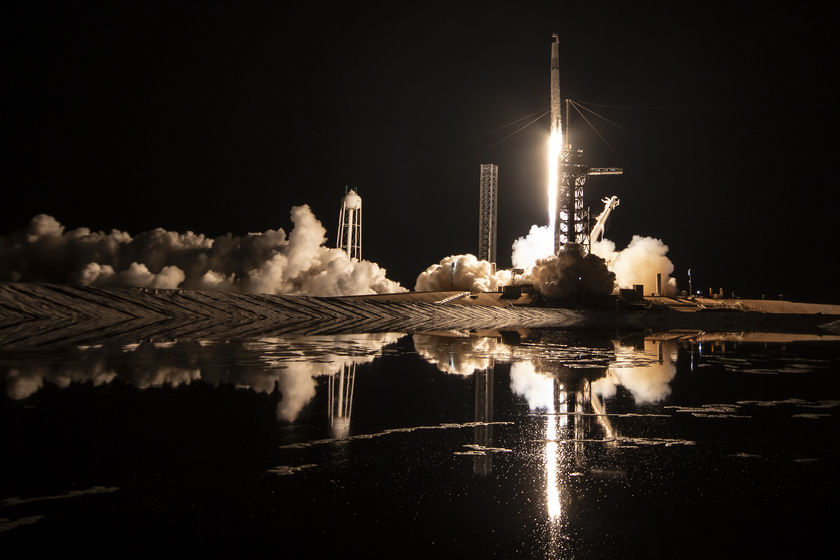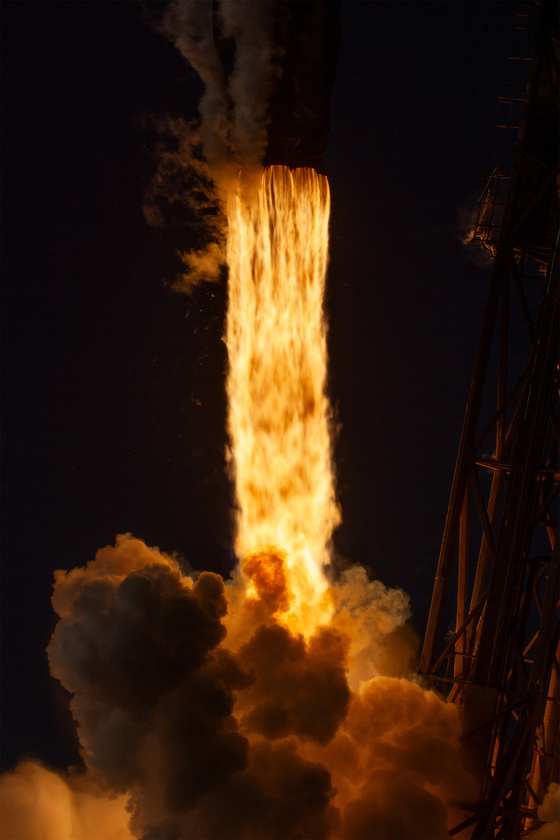A Falcon 9 rocket launched SpaceX's newest Dragon spacecraft, named "Grace," at 0631 UTC on June 25, 2025, from Launch Complex-39A at NASA's Kennedy Space Center. The Ax-4 mission for Houston-based Axiom Space, to the International Space Station (ISS) is carrying former NASA astronaut Peggy Whitson, who is also Axiom's director of human spaceflight. Alongside her are mission pilot Shubhanshu Shukla and specialists Sławosz Uznański-Wiśniewski and Tibor Kapu.
The Falcon 9 first stage booster (B1094) touched down safely as planned about ~8 minutes after liftoff at SpaceX's Landing Zone 1(LZ 1) at Cape Canaveral Space Force Station.
About a minute later, the Falcon 9's second stage completed its orbital insertion and deployed Dragon to begin the final leg of Ax-4's journey to the space station.
The Dragon spacecraft is scheduled to dock with the dorsal port of the space station's Harmony module at approximately 1100 UTC on June 26.
Grace is the fifth Crew Dragon in SpaceX's fleet, and was named by the Ax-4 crew, with its name symbolizing elegance and harmony in space exploration. Ax-4 is the Dragon's debut mission carrying the crew of four to the International Space Station (ISS). The spacecraft featured upgraded life-support systems, touchscreen controls, and autonomous docking capabilities.
The crew shared images of their mission's zero-g indicator, a plush baby swan toy named Joy, symbolized cultural values—wisdom (India), resilience (Poland), and grace (Hungary)—and signaled the crew’s arrival in microgravity.
The Ax-4 crew will spend about two weeks aboard the ISS, living and working alongside the seven long-term occupants of ISS Expedition 73. They will conduct more than 60 science experiments and STEM outreach events, the highest number on any Axiom mission to date, representing 31 countries, including the U.S., India, Poland, Hungary, and others.
The experiments focuses on:
Human Research: Studies on muscle regeneration and the impact of isolation on mental health.
Life and Biological Sciences: Investigations into how sprouts, edible microalgae, and tiny aquatic organisms grow and survive in microgravity.
Earth Observation: Research to support environmental monitoring.
Material Sciences: Technology demonstrations for future space applications.
The crew trained extensively for ISS operations, with access to the U.S. segment of the station, including the Columbus and Kibō modules. Educational outreach included interactive events with schools and communities in the crew’s home countries.
This mission marks the first time people from India, Poland, and Hungary have flown together to the ISS and represents the return of these countries to human spaceflight for the first time in 40 years It is also the fourth private astronaut mission to the ISS.
Whitson is a former NASA astronaut and Axiom Space’s Director of Human Spaceflight. She is the most experienced American astronaut, with 675 days in space prior to this mission. This was her fifth spaceflight and second time commanding an Axiom mission. She holds records for the most spacewalks by a female astronaut (10) and the most cumulative time in space by a U.S. astronaut.
Shukla is a Group Captain in the Indian Air Force and an astronaut with the Indian Space Research Organisation (ISRO). Shukla became the second Indian to reach space and the first to serve in a critical operational role on an ISS mission. With over 2,000 hours of flight experience, he trained at the Yuri Gagarin Cosmonaut Training Center in Russia and is part of India’s Gaganyaan program, set for 2027.
Uznański-Wiśniewski is a European Space Agency (ESA) project astronaut from the 2022 Astronaut Reserve Class. Uznański-Wiśniewski was the second Polish astronaut to travel to space and the first since 1978. An engineer with experience at CERN’s Large Hadron Collider, he trained extensively in Europe, Japan, and the U.S. for the mission, carrying the Polish flag from the 1978 mission.
Kapu is representing the Hungarian to Orbit (HUNOR) program. Kapu was the second Hungarian astronaut to reach space and the first to visit the ISS. A mechanical engineer with expertise in space radiation protection, he was selected from 247 applicants and trained at NASA facilities.
"It has been more than 40 years since the first person from India, Poland and Hungary has been to space, and through this commercial space opportunity we are accelerating the national space programs in each of these three countries and creating new pathways for technological advancements," Whitson said at the crew's January press conferece. "I'm sure this crew is going to be inspiring a whole new generation of young people."
This is the second Axiom astronaut mission to the ISS that has been sponsored in part by another national government or the European Space Agency (ESA). Of the 60 experiments to be carried out by the Ax-4 crew, 17 are being supported by ESA and Poland, and 25 through Hungary's orbital astronaut program HUNOR.
"Each country who comes brings something different than what we have in the normal suite of what we see for our research," said NASA's ISS program manager Dana Weigel during a May 20 Ax-4 press call. "It really expands the breadth of what we can do with research and the number of countries, institutions, academic organizations, etc., who participate."
Thursday's launch was initially scheduled for June 11 but was delayed due to high altitude winds and a leak aboard the ISS.
The space station's aftmost module, Zvezda, has experienced an ongoing leak for more than five years now, but has remained stable during that time. Last week, a change in the pressure data that monitors the leak prompted NASA to delay Ax-4 while they monitored the issue.
















